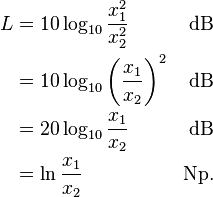Neper
The neper (unit symbol Np) is a logarithmic unit for ratios of measurements of physical field and power quantities, such as gain and loss of electronic signals. The unit's name is derived from the name of John Napier, the inventor of logarithms. As is the case for the decibel and bel, the neper is a unit of the International System of Quantities (ISQ), but not part of the International System of Units (SI), but it is accepted for use alongside the SI.[1]
Definition
Like the decibel, the neper is a unit in a logarithmic scale. While the bel uses the decadic (base-10) logarithm to compute ratios, the neper uses the natural logarithm, based on Euler's number (e ≈ 2.71828). The value of a ratio in nepers is given by
where  and
and  are the values of interest, and ln is the natural logarithm.
are the values of interest, and ln is the natural logarithm.
In the ISQ, the neper is defined as 1 Np = 1.
Units
The neper is defined in terms of ratios of field quantities (for example, voltage or current amplitudes in electrical circuits, or pressure in acoustics), whereas the decibel was originally defined in terms of power ratios. A power ratio 10 log r dB is equivalent to a field-quantity ratio 20 log r dB, since power is proportional to the square (Joule's laws) of the amplitude. Hence the neper and dB are related via:
and
The decibel and the neper have a fixed ratio to each other. The (voltage) level ratio is
Like the decibel, the neper is a dimensionless unit. The International Telecommunication Union (ITU) recognizes both units.
Applications
The neper is a natural linear unit of relative difference, meaning in nepers (logarithmic units), relative differences add, rather than multiply. This property is shared with logarithmic units in other bases, such as the bel.
Particular to the neper, however, is that the derived unit of centineper is asymptotically equal to percentage difference for very small differences – since the derivative of the natural log (at 1) is 1; this is not shared with other logarithmic units, which introduce a scaling factor due to the derivative not being unity. The centineper can thus be used as a linear replacement for percentage differences. The linear approximation for small percentage differences,
is widely used, particularly in finance—see for example the Fisher equation. However, it is only approximate, with error increasing for large percentage changes. Measured instead in centinepers, these linear approximations can be replaced with exact equalities, and applicable to any magnitude change, by defining the following centineper quantity for any change 
![D_{\delta} = 100 \cdot \ln\left[\frac{(1+\delta) -1}{1}\right] = 100 \cdot \ln(\delta)](../I/m/d3768402d00d0ceef3bca5fc143f4b0a.png)
See also
Notes and references
- ↑ Bureau International des Poids et Mesures (2006), The International System of Units (SI) Brochure, 8th edition, pp 127-128.
External links
- What's a neper?
- Conversion of level gain and loss: neper, decibel, and bel
- Calculating transmission line losses
| |||||||||||||||||||||||||





